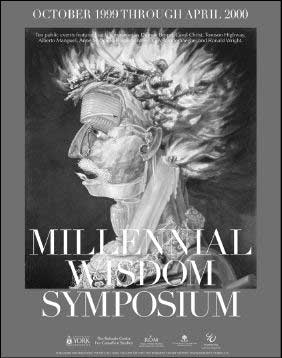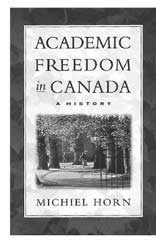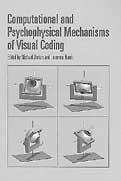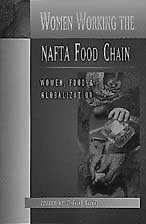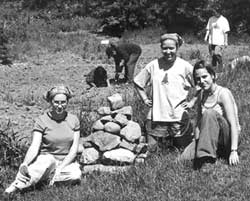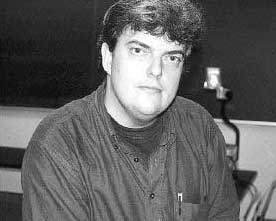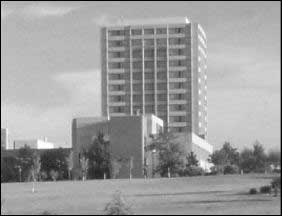
|

|
| | |
| | VOLUME 30, NUMBER 7 | WEDNESDAY, OCTOBER 27, 1999 | ISSN 1199-5246 | | |
| | ||
|
|
The Ontario/Baden-Württemberg (O/B-W) Student Exchange Program began a decade ago as an initiative of the Ontario government and the governmen of Baden-Württemberg. In 1989 Maria Cioni, now director of York International, led a study tour of representatives from York and other major Ontario universities to universities in Baden-Württemberg, in her capacity as director of the Research, Support and International Activities branch of the Ministry of Colleges and Universities. The O/B-W program was coordinated for the Ontario universities by Mark Webber, now associate director of the Canadian Centre for German and European Studies. He was awarded the Bundesverdienstkreuz erster Klasse, the German equivalent of the Order of Canada, for his work in furthering Canadian-German and German-Jewish understanding through the exchange program. York University housed the program office for the first five years. At present, Queen's University is home to the program office and in July 2000 the University of Western Ontario will succeed Queen's as the operating institution. The program is made possible through a joint initiative of the Ontario Ministry of Training, Colleges and Universities, and the Baden-Württemberg Ministry of Science, Research and Arts. The two provinces enjoy a special relationship in the areas of high technology, business, government, education and the arts. To date, over 800 students have participated in the program. Ontario students receive a government stipend to cover air fare and receive extensive advising and orienting support as well. There are no tuition fees at Baden-Württemberg universities. The German state provides an intensive immersion language course before term, free of charge. | |
|
|
The 1999-2000 Robarts Lectures, spearheaded by author and York humanities Professor Susan Swan who is the Robarts Millennial Chair in Canadian Studies, got underway on Oct. 4 at the Royal Ontario Museum (ROM) Theatre. It was standing-room-only to hear critic and anthologist Alberto Manguel, award-winning novelist and poet Dionne Brand, and Dr. Edward Keall, curator of Near Eastern Exhibits at the ROM. Titled "Making Up the Past: The Archeology of Fiction", this year's lectures are a series of 10 events - a moveable millennial wisdom symposium - at both York University and ROM, featuring 18 prominent novelists, historians and archeologists. They will focus on the way we recreate the past in popular culture. "Is the Past a Fiction?" was the question under discussion at the first event. Keall began the evening with a look at how we narrate the ancient past. Using the saga of one of his archeological "finds" as an example, he spoke of the enthusiasm of archeologists and historians attempting to piece together historical fact from fragments of material, how interpretation of fragments can colour our view of history, and how quickly, with new facts coming to light, our view of history can be changed. The archeological site he began working on in 1968 was a Persian castle, circa 150 CE. Located on the Silk Road to the Far East, Keall's discoveries led him to believe the castle was the stronghold of a "robber baron" who attacked caravans, or exacted tolls from them, and led to the documentary film on the subject, Silk Bandit. Recently Keall's work itself has come under attack from a Kurdish scholar who has discovered new evidence that the castle was the centre of power of the earliest known Kurdish ruler, the first of a distinguished dynasty, not a Persian thug. Keall considered that history is open to wide interpretation and that our view of it changes continually with the passage of time. Brand, a novelist of brilliant words and smiles, told the gathering how her view of history and her visit to an old British colonial museum in the Caribbean influenced her latest novel, At the Full and Change of the Moon. Warming to her topic of "The Dispossessed Past", Brand spoke of her reflections on the past while viewing a number of items in the museum. The museum covered the history of the period so poorly, she said. But cargo lists of slave traders and carefully drawn maps and sailing routes made her reflect on the human condition and the authors of these lists. A prison dress, stiff and mildewed, worn by a slave woman, drew her to one of the main characters in her book. Writings of priests and planters led from their experience to her writer's fiction. Brand mused about what these items meant then and what they mean now to her as a black woman and a writer - the records versus reality. "History opens and closes," she said. Manguel spoke about why we are haunted by the past. The author of The Dictionary of Imaginary Places among many works, discussed some classic fiction and how some of it haunts us because we recognize truth in it. The voyage of Ulysses, for example, is a wonderful adventure, the part of the book that rings truer than other events is Ulysses' homecoming because this is something we can relate to. "Ninety per cent of the book is surprise," he said. "The last is recognition." It is this recognition of ourselves, our experience and our cultural mythology, no matter how small, that draws us to the past and to fictions based on the past. He talked, as well, about how we interpret the past, either from a nationalistic or a cosmopolitan viewpoint. Nationalists, he said, interpret history in a way favourable to their viewpoint, while for cosmopolitans the past is a great library of interest and information. What we must remember is that we are drawn to that history, to those writings that resonate with us. The second event, "Is the Only Thing we Learn from History that We Never Learn?", will take place on Nov. 8, at 5pm at York University. It will feature acclaimed travel and history writer Ronald Wright, Canadian historian and York Professor Marlene Shore, and Balkan scholar, ROM archeologist and York Professor Tim Kaiser. For information, call (416) 736-5499 or visit the Robarts Centre Web site www.robarts.yorku.ca.
| |
|
|
The Senate Sub-Committee on Honorary Degrees and Ceremonials would like to encourage the York community to submit nominations for honorary degrees. The committee reviews and recommends individuals for inclusion in a list of eligible candidates from whom the president and the chancellor select nominees for specific Convocation ceremonies in this or a subsequent year. Candidates for honorary degrees must meet one or more of the following general criteria: (a) eminence in his or her field; (b) service to humankind, Canada, Ontario, York University or a particular community in a significant manner; (c ) a benefactor of the University; (d) someone whose public contributions to society are worthy of emulation. Nomination forms may be obtained from the senate Web site (www.yorku.ca/senate) or by visiting or calling the University Secretariat (Room S-883 Ross Building; 736-5012). The form should be accompanied by a nomination letter, a curriculum vitae or biographical summary and other evidence of support. Nominations are accepted throughout the year and the sub-committee meets regularly between November and May.
| |
|
|
By Cathy Carlyle Visual Arts student Kelsii Nguyen, left, with Jennifer Ivey Bannock, a board member of The Richard Ivey Foundation and aYork alumna, and Marvi Ricker, the foundation's executive director, attended a ceremony in the Faculty of Fine Arts to mark the opening of a colour darkroom. York's Department of Visual Arts is not only seeing the light these days - it and all who work there are positively glowing with delight at a $150,000 donation made by the The Richard Ivey Foundation. Until recently, the department was in the dark with no colour photography darkroom. In October the foundation's Executive Director Marvi Ricker and Jennifer Ivey Bannock, a board member and York visual arts alumna, attended a ceremony in the Faculty of Fine Arts to mark the opening of the new, high-tech colour darkroom that was made possible through the generosity of the foundation. The newly-refurbished and expanded facility for photography and print-making comprises two rooms: the darkroom proper housing 15 enlargers and a large, state-of-the-art colour processor; and the other containing a digital satellite equipped with computer workstations, flatbed scanner, film scanner and digital film recorder. If all that isn't space-age enough, the way you enter the darkroom is like something out of a science fiction movie. You go through a curved door and, standing in a cylinder, close the door by sliding the wall around you. This revolves you magically into the darkroom without letting in any light. Visual Arts Professor Jon Baturin, who was the faculty project manager for the new facility, explained the impetus behind the initiative. "An in-depth understanding of the theory and practice of both colour and black-and-white photography is an essential underpinning of contemporary art production and professional studio and industrial practice," he said. "Practical experience working with traditional colour photo processes is also the best foundation for an understanding of colour theory." At the opening celebration, Fine Arts Dean Phillip Silver spoke of his gratitude toward The Richard Ivey Foundation. "They have high expectations about the kinds of programs they are going to support. I feel great pleasure and pride in knowing that we met those standards. The new facility will help our students soar in their artistic endeavours." In thanking the foundation, Vice-President of Advancement Gary J. Smith spoke of the importance to students of having such a "first-class facility in a first-class university with a first-class faculty. I want to thank The Richard Ivey Foundation for this tremendous gift. I hope for a long association between the foundation and York," he said. Kelsii Nguyen, a visual arts student in her final year, said she could not contain her excitement when she returned from Asia this Fall to discover that rumours about a new darkroom were in fact true. "What we had before was old and underdeveloped space and now we have new technology to work with. When I walked into the new facility, I was amazed. The foundation's generosity and dedication to York University and its students has filled me with awe," she said.
| |
|
|
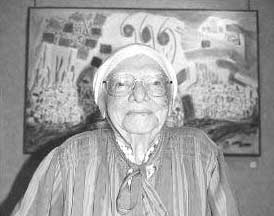
By Nishat Karim Hannah Sandberg Her paintings are uplifting...spiritually captivating... and magical. At first glance, the vibrant colours give even a novice viewer an inviting feeling of warmth. At second glance the eyes are overwhelmed and can't help but follow the beautiful lines etched in vivid reds, blues and yellows. If one painting can make a person feel so much, imagine what a roomful can produce. Well from now until January, the York community has an opportunity to find out. Presented at the Faculty Club of the University is a special showing of the works of a talented woman named Hannah Sandberg, who was once artist-in-residence at Stong College, and who, over time, has captured interpretations of entire passages of the Bible in her paintings. Inspired by the Bible, Sandberg uses its verses throughout her collection. Each painting consists of one sentence in Hebrew lettering produced as an interpretation using calligraphy and colour. The words are not always legible as a sentence, but rather they tumble, sink and soar, depending on her vision and the interpretation she wishes to express. Just as every great artist has their personal technique to creating beautiful work, so does Sandberg. Firstly, she will only paint when she has mixed the perfect colours and will not settle for a tone that she is not completely content with. Secondly, even if the colours are perfect, Sandberg will not paint when feeling the slightest bit upset or sad. Only when feeling content in her heart can she express herself through this art form. There have been times when days, weeks and even months have gone by before she feels ready. Each painting though, is well worth the wait. Just by observing the upward motion created in each of her works, we can see that Sandberg's happiness is quite evident in her paintings which appear almost heavenly. Sandberg born in Safed, Israel, comes from a heritage rich in Kabalistic traditions, where her father would read from the Shabbat Psalms with her every Saturday afternoon. Even at an early age, she longed to paint and with the encouragement of her father, she did. Later she married Mordecai Sandberg, an internationally known composer, who practised medicine in Israel for 16 years before devoting himself to music completely. Like his wife, he too was devoted to the Bible and spent his life setting the Bible to music. Together they travelled to England, France and the United States before coming to York University where they were invited to teach. As artist-in-residence from 1976-1978, Hannah felt a strong bond with her students, and to this day she has been unable to separate herself from York and its people. Don't be surprised if you find her in the Faculty Club appreciating the atmosphere as you admire her paintings. | |
|
|
By Marlene Shore Academic Freedom in Canada: A History by Michiel Horn In 1945, John Bartlet Brebner, a Canadian historian at Columbia University, surveyed Canadian universities for the Social Science Research Council. He noted they were regarded "by the public, and to some degree by themselves, as service institutions of a narrow utilitarian kind...." The battles over academic freedom which plagued McGill University during the 1930s persisted because "there was not a sufficiently intense conviction that the Faculty of Arts is the pulsing heart of a university." In Academic Freedom in Canada: A History (University of Toronto Press, 1999), Glendon College history professor, Michiel Horn, examines the evolution of academic freedom in Canada's universities from the 1850s through the 1960s. Mirroring Brebner's observations, Horn links the history of academic freedom in Canada with Canadian intellectual history. John Graves Simcoe, first lieutenant-governor of Upper Canada, once said: "Nothing is more essential than to profess correct opinions...." Horn shows that similar convictions served most Canadian academics. They defined their roles narrowly, eschewing controversy because they felt vulnerable and didn't want to damage their careers. The result: an acquiescent, largely middle-class professoriate unwilling to challenge authority. Horn documents the sources of this timid conservatism and appraises the individuals who challenged conventions, and the reactions they provoked. His study is framed by his conviction that universities are not repositories of approved ideas and attitudes, and do not exist primarily to make people feel intellectually or emotionally "at home". He argues that academics owe a loyalty to something more important: "They must commit themselves to the search for knowledge and truth as they see it." Academic freedom and tenure fostered conditions in which they could research and publish findings that challenged conventional wisdom without fear of retaliation. Academic freedom has two meanings: the university's political autonomy and the freedom of teachers and researchers to do their own work. Horn is concerned with the latter - freedom within the university and freedom of professors to play a public political role. Three major issues affected academic freedom in Canada: religion, economics and traditions of conservatism and loyalty. The latter stemmed from the United Empire Loyalists and continued through the late 1800s after the UEL influence waned. In the mid-1800s neither teaching nor scholarship in Canada was safe from religious and moral orthodoxy. Between 1914 and 1920, Canadian universities were quiet while faculty and students went overseas to fight and during the massive social unrest which followed. During the war, patriotic conformity endangered academic freedom in the classroom - at the University of Toronto, three German nationals were summarily dismissed. Outside the classroom, public criticism of one's institution could lead to termination. By the 1920s, the political role of professors and the issue of free speech erupted, prompting new attempts to restrict academic freedom. Moreover, hiring practices affected academic freedom by excluding candidates who were regarded as "difficult" or "radical" and by systemic discrimination based on gender, ethnicity, religion and even class. The Great Depression and the renewal of war in Europe prompted some professors to claim the rights of free speech in order to criticize capitalism and the British connection. Some "radicals" were tolerated; a few were expelled for their political beliefs, including Eugene Forsey and Leonard Marsh by McGill, and the Social Science Research Project, in which they were both involved, was terminated. The University of Toronto threatened historian Frank Underhill with dismissal because of his criticism of Canadian patriotism to the British Empire, and expression of pro-American sentiments. While World War II placed constraints upon academic freedom, some academics spoke publicly to issues of social and economic change that would have been difficult 30 years earlier. Still, there were consequences for those who did speak out - in 1947 Frank Scott was passed over for appointment as dean of McGill's law school because of his connection with the CCF. In the 1950s, Canadian universities shone by comparison with the McCarthy-driven actions of their US counterparts, but that did not mean that academic freedom was safer here - with rare exceptions, the CCF had been as far left as Canadian professors had ever been inclined to stray. Nevertheless, some Canadian universities laudably became havens for US academics driven out of their own country. Horn extensively discusses the late-1950s Crowe affair. Harry Crowe's dismissal by the self-consciously Protestant United College in Winnipeg, after some private correspondence landed on the principal's desk, led to the first-ever inquiry by the Canadian Association of University Teachers, which concluded that Crowe's tenure had been infringed. In the letter, Crowe questioned the college's fundraising efforts (a federal grant was being put towards building improvement rather than professorial salaries) and expressed his distrust of religion. Sixteen men and women left United College in support of Crowe who, after working as research director of a national labour union, was appointed to Atkinson College in 1966. By the mid-1960s, the future of academic freedom in Canada looked bright until the student movement, the university's decline in public esteem and reductions in university funding, raised new challenges. Horn ends by considering how these and more recent developments - exponents of political correctness challenging academic freedom in its traditional sense and the business values of multinational corporations - pose threats to university autonomy as well as to academic freedom.
Marlene Shore is a professor of history in York University's Faculty of Arts and acting director of the Graduate Programme in History. Shore publishes in the field of the history of social and behavioural sciences and is the author of The Science of Social Redemption: McGill, the Chicago School, and the Origins of Social Research in Canada.
| |
|
|
By Michael Todd Computational and Psychophysical Mechanisms of Visual Coding (Cambridge University Press, 1997), edited by computer science Professor Michael Jenkin and psychology and biology Professor Laurence Harris, has chapters from some of the most active contributors in the field of visual coding. It describes some of the ingenious mechanisms used to code descriptions of visual phenomena in both the biological and computational communities. English Professor Arun Mukherjee's Postcolonialism: My Living (TSAR Publications, 1998) offers finely nuanced and informed readings of a variety of authors. The book's essays show the inadequacy of postcolonial, feminist and postmodern theories currently fashionable in western academies.
Women Working the NAFTA Food Chain: Women, Food and Globalization (Second Story Press, 1999) edited by environmental studies Professor Deborah Barndt features a number of essays by York contributors focusing on how NAFTA affects the food system and its women workers. When we purchase fruit in a supermarket, order takeout or sit down to a meal in a local restaurant, we become the end-consumers of a global production and distribution process that depends heavily on women's labour, argue the authors. The book considers what constructive alternatives can be used to feed our world in a more humane and sustainable way. Social science Professor Linda Briskin is co-editor of a new book, Women's Organizing and Public Policy in Canada and Sweden (McGill-Queen's University Press, 1999). The volume highlights the practices of unions and political parties in these two welfare states and the effect that women's organizing has had on the framing and implementation of public policy. The editors, while making women's agency visible, also attempt to understand the possibilities and constraints posed by the institutional, political and discursive contexts in both countries.
| |
|
|
By Cathy Carlyle If you'd sauntered past the southwest reaches of the York campus early this past summer, you might have thought you were looking at an archaeological site. The stones piled like a cairn seemed to be saying something. Artifacts, unearthed, rested expectantly on the grass. Men and women toiled in the heat of the day, removing larger relics and laying them on the ground nearby. This was a dig into the past, but not the romantic kind associated with archaeology. It was the beginning of the Maloca Garden, an enterprise that was chosen recently for the City of Toronto "Thank You Green Toronto" award. The new award acknowledges the "outstanding effort" of the students who initiated it, "in the beautification, greening and community enhancement of the city". York students dug into the project - literally - removing stones, rusty chicken wire, implements and vinyl fencing entrenched at the site about a decade ago by other gardeners. These would-be veggie and flower-growers of the late '90s and into the next millennium were eager to get their hands on and into the soil at an area they called the Maloca Garden. It is located south of Building 8 Residence - one of those brown high-rises - and west of Parking Lot B. Although the name Maloca has an exotic ring, suggestive of a site where you would find antiquities, "it is South American in origin and means communal meeting place, a sacred, spiritual place, a place that receives and gives life," said Angela Simone, co-founder and coordinator of the garden and a masters student in environmental studies. "We see the name as a metaphor for the garden at York." She said that the garden "addresses sustainability issues on campus" by encouraging students to grow some of their own food using hand tools and organic methods. "Studies have shown that students don't eat nearly enough vegetables and fruits," she said. "We hoped that this garden would be a means for people to access nutritious locally-grown, chemical-free food. We were attempting to build 'community' and nurture a sense of belonging on campus." The seed for the garden was first planted nearly three years ago but the idea didn't reach fruition until Simone, who had had experience starting community gardens, got people mobilized, aided by environmental studies undergrad Karen Okamoto. Last November they were hired by the Ontario Public Interest Research Group through York's Work/Study Program to get the idea off the ground - or, rather, INTO the ground. Simone wrote an in-depth proposal to the Land Use Coordinating Group (LUCG) at the University for permission to use campus land for a community organic vegetable garden for York summer residents. While awaiting confirmation, she and Okamoto did not let the grass grow under their feet. They went ahead with their plans and continued to solicit start-up funds from various organizations, and reached out to the University student body by placing posters in residences and holding informational meetings. As well, they held an informal idea exchange for prospective gardeners. "It was a frustrating and difficult time, not knowing if we would be given the go-ahead," said Simone. "But we didn't stop planning. By January we had a working group and the beginnings of a group of gardeners from the Faculty of Environmental Studies. The dean [Peter Victor] was a great supporter." Not all of the gardeners are from that Faculty, though, she pointed out. The word came through in March: the land could be used by students for growing food. LUCG gave the would-be gardeners a contract by which they had to abide. They also came up with their own rules, agreeing among themselves to maintain their plots, not to shade others, to put in at least 10 communal hours - which could include holding workshops, doing maintenance etc. Student gardeners and their family members pitched in to get the 20 to 100 square-foot plots prepared. "The initial clean-up of all the junk took three solid days for 10 to 15 people," said Simone. "It was a bonding experience. We all worked together, digging by hand. It created a sense of ownership. The students had a sense of pride in the place even before they'd planted anything." While eating a potluck meal under the shade of a chestnut tree after one work day, they had informal talks on composting and the basics of gardening. "It felt like a real community was being formed." Melissa Tkachyk, an MA student, and Kathy Sestan, an undergrad - both in environmental studies - were hired for two months through the York Work/Study Program to work as "garden events facilitators". They were responsible for organizing workshops, work parties and barbecues, getting supplies, ensuring that gardeners had access to water, answering e-mail enquiries (york garden@tao.ca), thanking donors and collecting the $10 per plot fee that went towards purchasing garden-related material and running field trips and more workshops. The facilitators planned to continue as volunteers after their funding expired. "The Maloca Garden made a real community out of people who didn't even know each other before," said Sestan. "A community garden doesn't shut people out. I've learned much more from doing this than just sitting in a lecture hall. It's so important for the children, too, who help their parents. They can learn about their environment, which they often don't have a chance to do in school." Tkachyk echoed, "They probably think that food comes straight from the grocery store. Here, we're all learning about gardening together." Although most gardeners lived on campus, she bused in to work on her plot. "One day I carried my compost on the bus in a garbage bag," she said, "No one stood near me. I don't think I had it closed properly!" Gardeners received donations from Home Depot in Woodbridge, Canadian Tire at Keel
| |
|
|
| |
|
|
York University is in the process of updating its data on the representation of aboriginal peoples, men/women, persons with disabilities and racial/visible minorities. York compiled data originally in 1990 through a questionnaire to all employees, and has kept that data up-to-date during hirings. The data have helped maintain compliance with the Federal Contractors Program (FCP) for employment equity under which employers must implement employment equity to remain eligible for contracts of $200,000 or more. In fact, York won a Vision Award for employment equity from the federal government in 1994 and has just completed a second very successful compliance review. Over time, however, situations change and the FCP expects the University to ensure that the data are both accurate and up to date. For example, some individuals may not have had a disability when they joined the York community, but may have one now. The Institute for Social Research is sending out a short questionnaire to administrative and support staff, mostly by internal mail, asking employees to complete the survey, self-identifying their equity status. The questionnaire is confidential and information will be aggregated into tables so that individuals cannot be identified. It will be used only for employment equity purposes. Please return the form to the Institute for Social Research. Your help is greatly appreciated. Anyone with questions or concerns is asked to contact Gill Teiman, special assistant to the president (Equity) at extension 55706 or e-mail gteiman@ yorku.ca.
| |
|
|
By Cathy Carlyle The sometimes unfathomable field of science may seem to be at the opposite pole to the somewhat esoteric field of religion, though a visiting lecturer says there is interest in whether there is and/or was a symbiotic relationship between the two. John Brooke, professor and Chair of science and religion at Oxford University, examined the relevance of religion to science at a Brown Bag seminar in September, particularly their relationship in the past. He probed the history of science and examined samples of where the study of the secular field was overlaid with the sacred, and where there was "engagement as well as disengagement" between the disparate fields. Even something like the Natural History Museum in London, dubbed "the cathedral of science", has something of the sacred in the secular, said Brooke. The architecture of the building strongly resembles a traditional place of worship. He then conjectured if the sacred may sometimes be discernible in the architecture of scientific theory. "It may be far from obvious how the study of earthworms or the dissection of barnacles could be laden with religious meanings." However, he added, "There are telling examples... in the iconography of early modern science where religious and experimental practices often coalesced." To illustrate his point, he showed a slide, Heinrich Khunrath's Amphitheatrum sapientiae aeternae (1598), which depicts an oratorium (place of prayer) next to a laboratorium (place for alchemical experiment). "But they are under the same roof. Having achieved an appropriate spiritual state and having sought divine blessing on the experiment, the alchemist passes continuously from the one to the other." In fact, said Brooke, experimental practices were justified in theological terms for much of the 17th century. "Robert Boyle [philosopher and scientist] spoke of a sense of divine guidance in the very execution of chemical experiments. 'Pregnant hints' was how he described the assistance he had received from the greatest of all chemists, sparing him dreadful explosions and other chemical mishaps." Essayist and philosopher Sir Francis Bacon firmly believed that practical application of knowledge acquired through experiment had a religious meaning. Bacon's theory was that the knowledge humans had and lost in the "Garden of Eden" was there to be recaptured through the study of science, said Brooke. Even botanist Charles Darwin, deemed by some to be an enemy of orthodox Christianity, spoke in religious terms. "It was from a series of barnacles that he illustrated the gradual emergence of separate sexes from an unknown hermaphrodite ancestor," said Brooke. "It was when he was reporting this work...that he declared, 'my species theory is all gospel'." Brooke also pointed out that in the Origin of Species Darwin spoke of the "laws" of nature as having been impressed upon matter by the Creator. He said that he wasn't able to annul the implications of his earlier belief that each species and all of its parts had been purposely created. Sir Isaac Newton, mathematician and physicist, is the one that Brooke turned to most often to back up his ideas on how relevant religion was to science. "To celebrate God for his eternity, immensity, omnisciency, and omnipotency is indeed very pious and the duty of every creature", is what Newton wrote, said Brooke. He believed that what he saw as God in nature was the same presence at work in human history. However, he allowed that, simply because scientists talked of theological concepts in their texts on natural history, it did not necessarily mean that they believed what they professed. Some might have given religious references as a way of gaining attention, he said, or as a "veneer to cover what might be a subversive thesis". Edinburgh publisher Robert Chambers is one such man who publicized his theory of organic transformation as a work of natural theology. In private he admitted that he couched it in such terms to smooth the ruffled feathers of those he called "the saints", he said. One of the difficulties Brooke encountered in making his argument for the relevance of religion to science was corroborating evidence. He said even if you knew that Newton spent an enormous amount of time on bible study, carried out many charitable works, and abhorred levity in religious talk, that was not sufficient evidence to say that his religion was imprinted on his scientific work. "A minimal supplement would have to be some textual support in which a move from theology to natural philosophy is made explicit," he said. He added that, in Newton's case, there are many such texts. He had some suggestions for confirming whether or not there have been religious or anti-religious influences on scientific content. First, you should look at a scientist's conditional statement, such as, "If intelligent life were to be found on other worlds it would compromise the Christian revelation." Then you should see if the conditional statement is part of a clearly discernible polemical program and ascertain if the scientist was actively trying to substantiate his/her hypothesis and practices. Brooke talked of the French organic chemist and scientific "guru" of the Third Republic, Marcellin Berthelot. Berthelot believed that if organic systems could be synthesized artificially, that would be a mortal blow to religious superstition. To that end, he spent a lot of time in synthesizing increasingly complex organic compounds from their elements. "Is this not a case where it is reasonable to claim that the religion of a secular positivism was stamped on his science?" asked Brooke. Berthelot also believed that atoms were non-existent, saying that they were as much a part of superstition as the idea of bread and wine at Catholic mass. "The consequence was that, in a particular place and time, Paris in the late 19th century, atoms were not part of the content of science," said Brooke. "Under Berthelot's authority, they had even disappeared from that catechism of science: the scientific textbook. If a secular positivism could so palpably shape the content of science it may, after all, be more than merely plausible to claim that other forms of religion have, in their time and place, left their signature," he concluded.
| |
|
|
By Nishat Karim York University has four categories of annual University-Wide Teaching Awards that it presents for excellence in teaching. Over the next few weeks, this series will continue to showcase each of the 1999 recipients from the categories of senior full-time faculty, full-time faculty, contract/part-time faculty, as well as teaching assistants. Presented during convocation, these awards are sponsored by the York Parents' Association and the recipients are selected by the Senate Committee on Teaching and Learning. Judith Rudakoff Ask Professor Judith Rudakoff anything about the theatre and she'll give you the answer. What makes her so qualified? She's a dramaturge, an author, a critic and a playwright. As a former literary manager and resident dramaturge she is well recognized at the Toronto Free Theatre, the Canadian Stage Company and the theatre Passe Muraille in Toronto. For more than 15 years she has worked across Canada as well as internationally. This year, Rudakoff has been selected as the recipient of the 1999 Parents' Association University-Wide Teaching Award for Full-time Faculty. As a member of York University's Theatre Department since 1989, Rudakoff is also a Fellow of the Centre for Research in Latin America and the Caribbean. She teaches playwriting and contemporary Canadian theatre as well as coordinating the graduate and undergraduate program in playwriting. It comes as no surprise that with all of her accomplishments Rudakoff has also been the inaugural recipient of the Faculty of Fine Arts Teaching Award in 1998 and was York University's nominee for the Council for the Advancement and Support of Education 1999-2000 Canadian University Professor of the Year. In her classes she challenges, inspires and encourages students to explore their creativity in a supportive atmosphere. She provides a stimulating and practical learning environment that fosters intellectual growth and professional development. It has been noted that Professor Rudakoff has developed a system for "teaching the unteachable". With that, along with her passionate commitment, she has inspired her students with a genuine love of Canadian theatre.
| |
|
|
By Susan Scott Spanish guest lecturer, Prof. Nuñez Seixas spoke recently at York In last year's regional elections in Spain, more than 20 different parties got seats across 17 autonomous communities in the country. And Canada thinks it has problems with the Reform and Conservative parties vying for national public support. The issue of minority nationalisms and regional political parties in Spain captured attention at York recently during a lecture by Xose Manoel Nuñez Seixas, a modern history professor at the Universidad de Santiago de Compostela who's currently a visiting professor at Hunter College, City University of New York. He discussed the struggle for power amongst the three main nationalist parties - Basque, Catalan and Galician - prior to and after the country's leader, General Francisco Franco, ruled Spain from 1939 to 1975. The Basque region in particular in the northern part of Spain was granted autonomous state in 1980 but has lost support since then and has suffered a further decline this decade. Catalonia, also granted autonomy in 1980, is in the northeastern part of the country, while the Galician Coast is in northwestern Spain. Nuñez Seixas reviewed Spanish history following the country's civil war in 1939 when Franco became leader. He believes Franco was unsuccessful in forming a new nationalist country. "From 1939 on, Spanish nationalism was practically monopolized by Catholic-traditionalist discourse, with the addition of some Fascist touches," he said. In addition, Franco's attempt at nationalism didn't hinder the popularity of regional groups such as the Basques. Therefore, the survival of these "peripheral nationalist legacies", together with the partial failure of Spanish "authoritarian nation-building" cleared the way for Catalan, Basque and Galician nationalisms to flourish. By the 1960s, he says, the influence of Marxist-Leninist ideology took hold among the younger generation of nationalist activists. Together with the popularity of doctrines of "internal colonialism in Europe, the example offered by liberation movements in the developing world, caused a rise in new nationalist parties such as the Galician People's Union (UPG), the Catalan Liberation Front (FAC), and Basque Country and Freedom (ETA). After Franco's death in 1975, the national question reared up again. The results of the country's first democratic parliamentary elections clearly demonstrated the social influence of the minority nationalisms. Catalan nationalists garnered almost 27 per cent of the vote, while the Basques reached 39 per cent. The 1978 constitution tried to create a political solution to the nationalist question. It established a framework that combined the idea of Spain as a single political nation with the existence of autonomous status to all regions. Seventeen autonomous communities reassembled the existing 50 provinces. In some cases, areas overlapped. Nuñez Seixas says the constitution only muddied the waters. "On the one hand, it affirmed that Spain was the sole existing nation, and hence the sole collective entity enjoying full sovereignty," he explains, "But on the other hand, the existence of 'nationalities' and regions was also recognized, while the difference between a nationality and a nation was not clearly established." In addition, the minority nationalisms were divided. The majority of Basque voters abstained from voting in the constitutional referendum, while the majority of Catalan voters supported the constitution. However, overall, a majority of Spanish voters as a whole voted in favour of the new constitution. The other wrinkle in Spain's democracy was its entry into the European Union in 1986. Nuñez Seixas says the constitution didn't really allow for the participation of the autonomous communities in the creation of Spain's European policy. However, during the 1990s, this has partially been rectified by the establishment by the Spanish state of a forum to allow regional governments to take part in the country's European policy. Also during the 90s, Nuñez Seixas says support for further independence by the majority nationalisms is low among a majority of Spaniards, even those in areas such as Catalonia. The Basque separatist movement has also suffered a decline in public support. One reason for this general decline, he says, is the electoral performance of minority nationalist parties. "Spanish parties increase their results in national parliamentary elections, where the turnout is greatest, while peripheral parties obtain better results at regional elections," he says. Furthermore, he asserts there is no correlation between peripheral nationalists' election scores, national consciousness and support for independence. "This is also the case in Quebec, which has a long history of voting for one party in provincial elections and another in national ones." He calls Spain "a paradoxical example of failure for both state and peripheral nationalisms because not one of them has been able to impose its undisputed leadership over the territory."
| |
|
|
By Nishat Karim Norman Bethune College He worked on the front lines in China when Japan declared war on them in 1937. He wrote textbooks and taught young men and women how to be doctors, nurses and nurses assistants. Later with the help of that same group of people, he performed 115 operations in a short span of 69 hours. When Spain underwent a Civil War, this man volunteered his time to work for the Committee to Aid Spanish Democracy. Through this work he developed a unique group called the Canadian Blood Transfusion Service whereby individuals were able to donate blood to help those in hospitals. He became a hero to Spaniards after risking his life by driving into battles to save the lives of those front-line troops that were on the verge of death. Born in Gravenhurst on Lake Muskoka in March of 1890, Norman Bethune later became a well-known heart surgeon in Canada. In 1972, to honour this man who is internationally considered a symbol of self-sacrifice and service to others, the University chose to name what was founded as College "G" in 1971 after this remarkable humanitarian. Thus, Dr. Norman Bethune (1890-1939), a Canadian physician and social activist with an international reputation, will always be remembered and honoured by the York University community and the Norman Bethune College and Residence. | |
| | Current Issue | Previous Month | Past Issues | Rate Card | Contact Information | Search |
|
